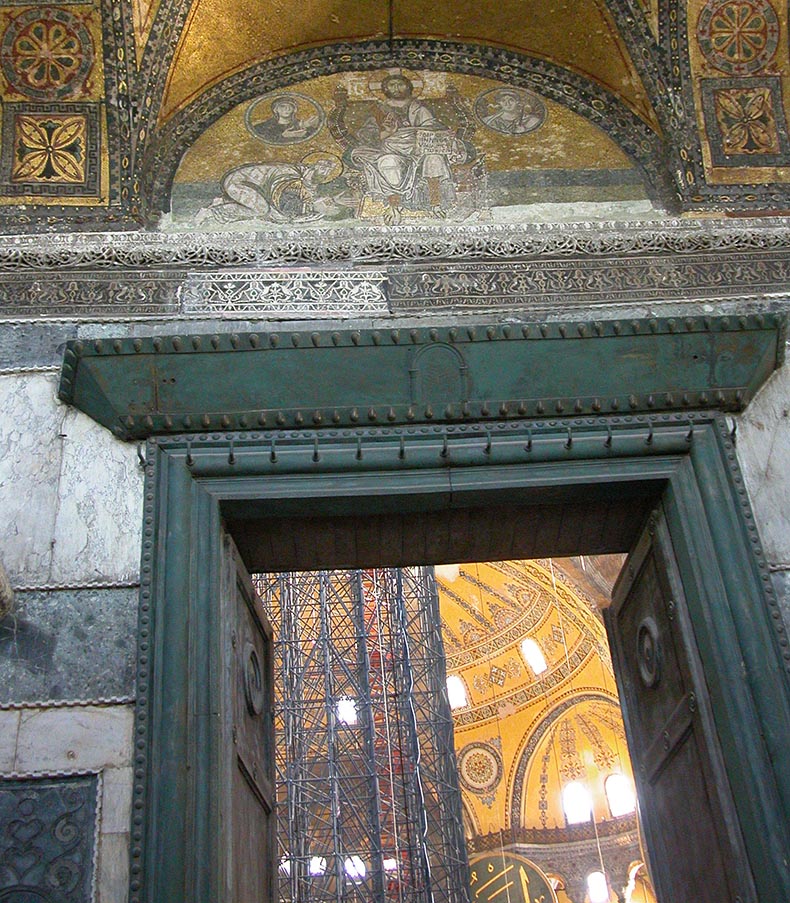 The center door was called the Royal Door and only the Emperor could pass through it on special days. At the ritual entrance of the Emperor to Hagia Sophia, holding a large candle, he would bow three times before this door, while choirs chanted. It's huge and massive planks were said to be wood from Noah's Ark, a story first recorded in the 9th century. The Partia Constantinopoleos informs us: “In the second narthex the doors were made of ivory (three to the right, three to the left, and between them) three other doors: two of the middle size, and between them there was the very big one of gilded silver. All the doors were gilded. Inside these doors instead of normal wood there was the Wood of the Ark”
The center door was called the Royal Door and only the Emperor could pass through it on special days. At the ritual entrance of the Emperor to Hagia Sophia, holding a large candle, he would bow three times before this door, while choirs chanted. It's huge and massive planks were said to be wood from Noah's Ark, a story first recorded in the 9th century. The Partia Constantinopoleos informs us: “In the second narthex the doors were made of ivory (three to the right, three to the left, and between them) three other doors: two of the middle size, and between them there was the very big one of gilded silver. All the doors were gilded. Inside these doors instead of normal wood there was the Wood of the Ark”
As described in the Partia the door was covered by sheets of silver-gilt. It was secured by a big and impressive silver lock. In Byzantine times the door was also known as the Silver Gates as well as the Beautiful Gates. On either side of the door hung an icon of the Savior and one Mary of Egypt and the Theotokos, brought here from the Holy Sepulchre in Jerusalem. Markings 7ft from the floor show where the icons were placed. The door was also known as Door of Repentance, above in the arch is a mosaic of the Byzantine Emperor Leo the Wise. He ran afoul of the Church by marrying too many times, once to the extraordinary beauty Zoe Karbonopsina "Dark-Eyes", who bore him a son and heir. On two occasions (Christmas 906 and Epiphany, 6 January 907) the emperor arrived in procession with the senate at this very door - only to be denied entry by the Patriarch Nicholas for his forth illegal marriage to Zoe. For this he was compelled to make penance for the sin of marrying too many times. In the mosaic you can see Leo prostrated before Christ. Although he was forbidden to enter the nave of the church, Leo was allowed to enter the church through the right aisle to walk to the private Imperial Metatorian at the end of the aisle where he could watch and listen to the liturgy in disgrace. In time the crisis was resolved and Leo was allowed to enter the nave again and receive the sacrament.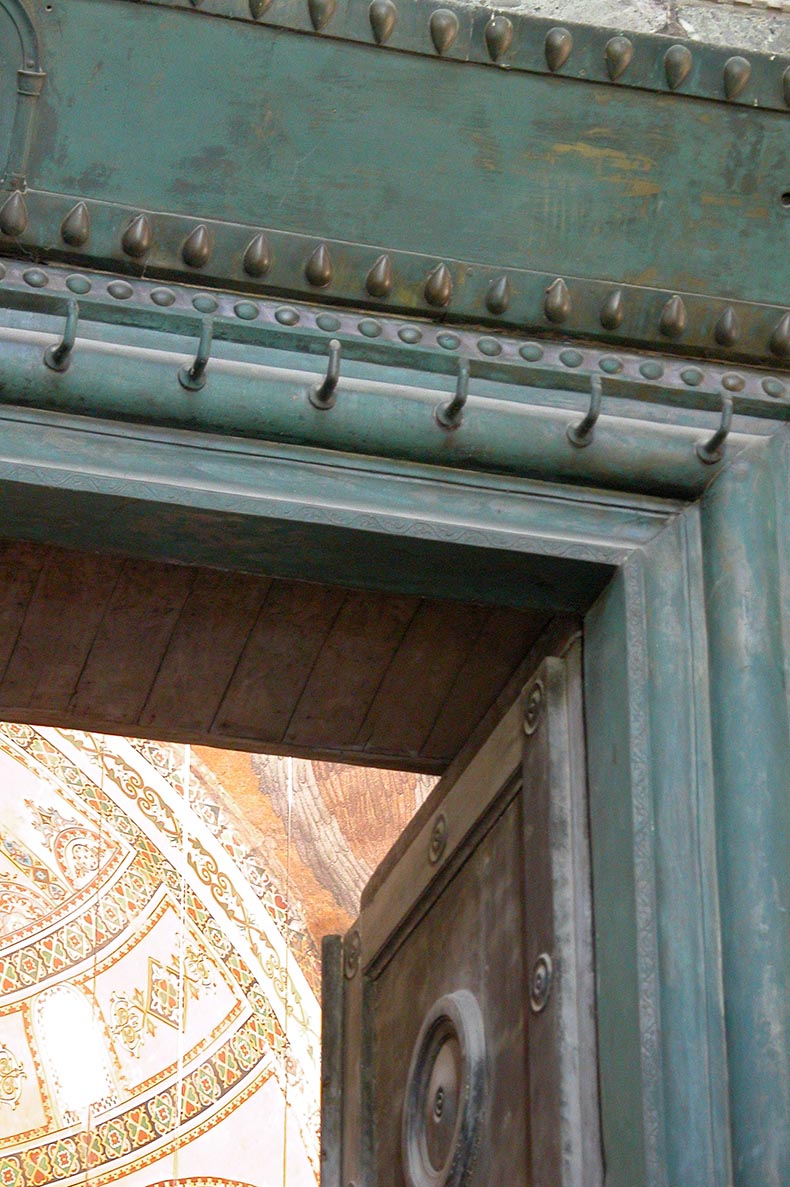 The door has a brass frame that dates from either the 6th century or the ninth century. Based on the style of the text, most recent scholarship supports a later date. Along the top are a series of hooks in the shape of fingers The brass has the same fine ornamentation in its borders as the other doors in Hagia Sophia. I don't know if the brass frame was ever gilded. I think not, since the only gilding method that could be oil based one. Brass can be kept polished to a very fine gold-like finish, let's assume that's what was done.
The door has a brass frame that dates from either the 6th century or the ninth century. Based on the style of the text, most recent scholarship supports a later date. Along the top are a series of hooks in the shape of fingers The brass has the same fine ornamentation in its borders as the other doors in Hagia Sophia. I don't know if the brass frame was ever gilded. I think not, since the only gilding method that could be oil based one. Brass can be kept polished to a very fine gold-like finish, let's assume that's what was done.
Anyone who wanted to enter Hagia Sophia had to have recently been to confession to be ritually pure. If you could not find a priest you could confess your sins to the icon of Christ and receive forgiveness through Him. In 1453, when the Muslim army hacked its way into Hagia Sophia it is unlikely they could have battered this door down. It was still probably covered in metal plates and the wood was too thick. So is the wood the original wood? I don't know.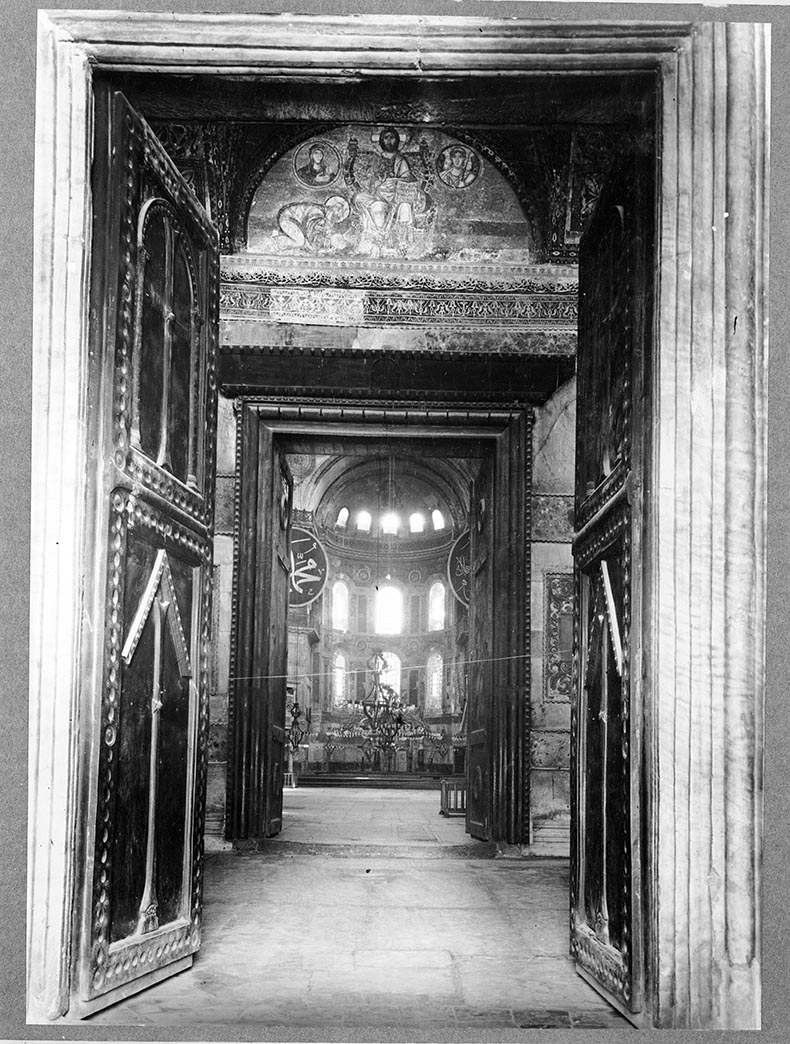 Here's a view through the doors showing what it looks like today. In Byzantine times there were only a couple of days a year when it was opened. When Hagia Sophia was a mosque this door was reserved for the Sultan and was covered with silk draperies with Koranic inscriptions. The fllor in front of the door still shows the impressions left by hundreds of thousands of Christian Pilgrims who knelt in from of the icons on either side of the door.
Here's a view through the doors showing what it looks like today. In Byzantine times there were only a couple of days a year when it was opened. When Hagia Sophia was a mosque this door was reserved for the Sultan and was covered with silk draperies with Koranic inscriptions. The fllor in front of the door still shows the impressions left by hundreds of thousands of Christian Pilgrims who knelt in from of the icons on either side of the door.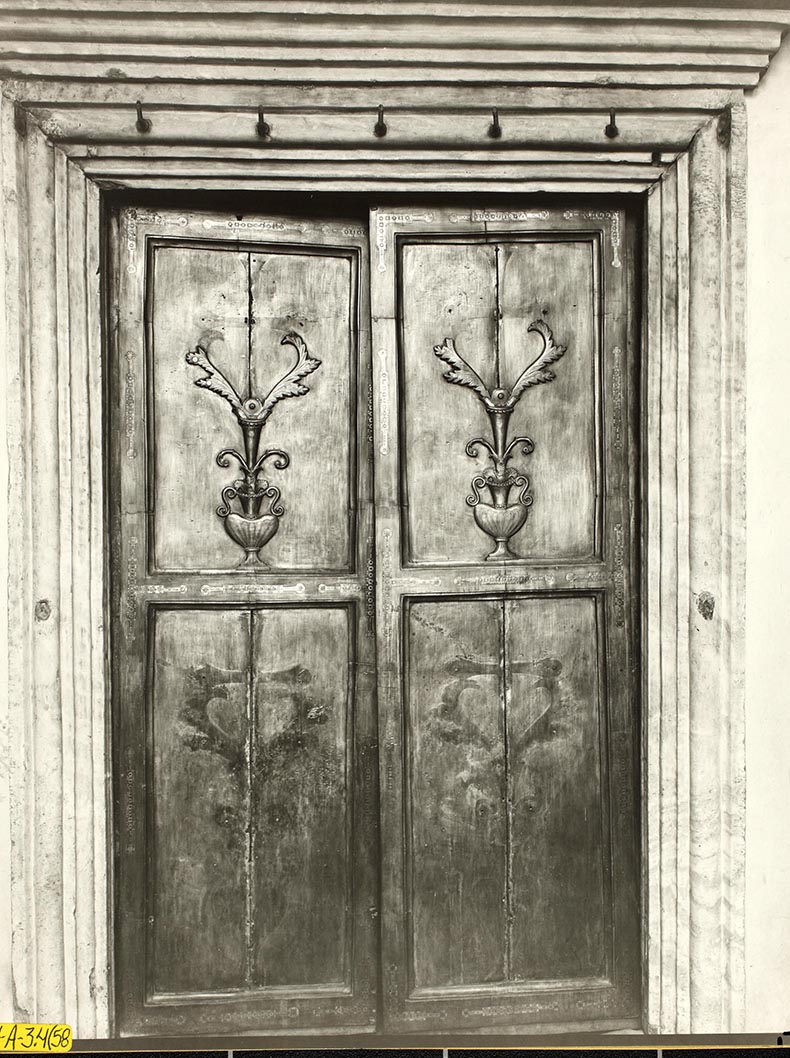 All of the doors have mythical stories of the origin of their wood. These were covered in bronze. The motifs are 6th century Byzantine interpretations of classical motifs like acanthus. The Byzantines were famous for their bronze doors that were inlaid with gold and silver, which were sent all over the Mediterranean. Clergy and monks from the West ordered sets of doors on visits to Constantinople directly from the makers. A number of sets of these doors have survived.
All of the doors have mythical stories of the origin of their wood. These were covered in bronze. The motifs are 6th century Byzantine interpretations of classical motifs like acanthus. The Byzantines were famous for their bronze doors that were inlaid with gold and silver, which were sent all over the Mediterranean. Clergy and monks from the West ordered sets of doors on visits to Constantinople directly from the makers. A number of sets of these doors have survived.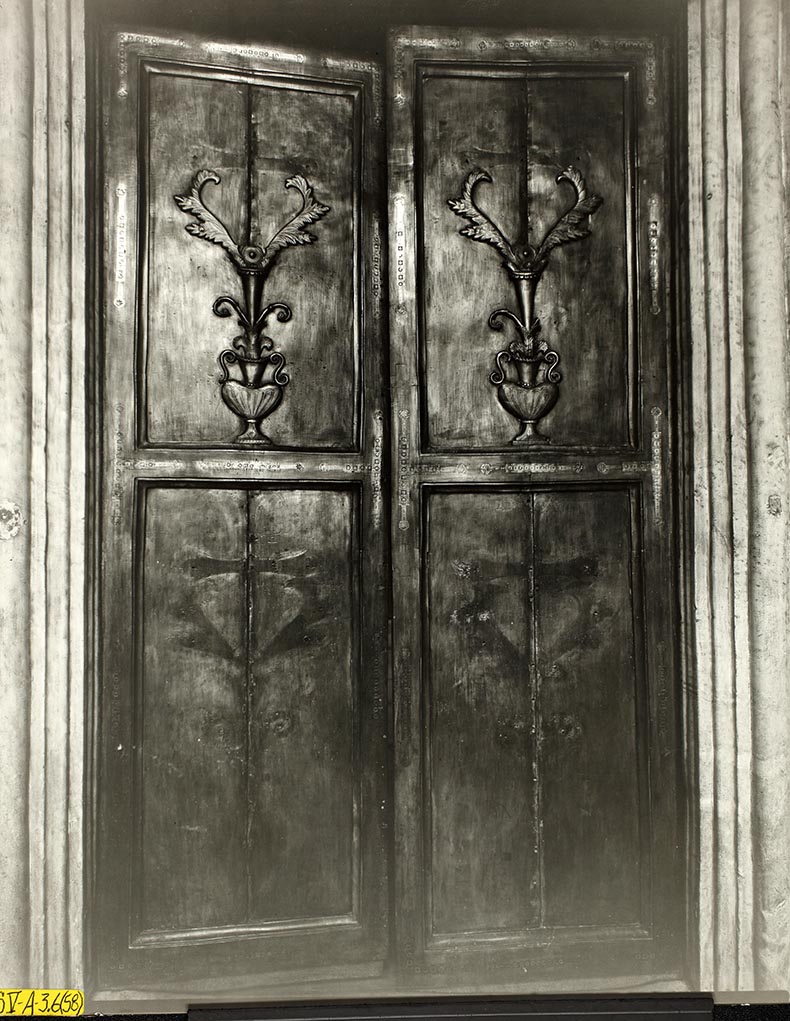 The bars of the crosses on all of the doors have been removed after Hagia Sophia was converted into a mosque. The rest of the ornament on the bottom panels has also disappeared.
The bars of the crosses on all of the doors have been removed after Hagia Sophia was converted into a mosque. The rest of the ornament on the bottom panels has also disappeared.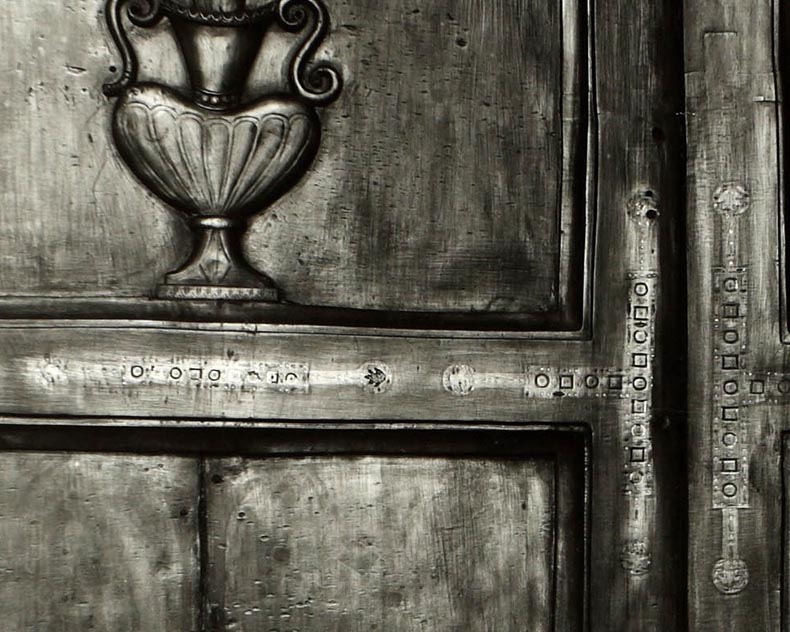 Here you can see areas of incised ornament that was gilded. These mimic metal straps that would have been used to secure wood panels.
Here you can see areas of incised ornament that was gilded. These mimic metal straps that would have been used to secure wood panels.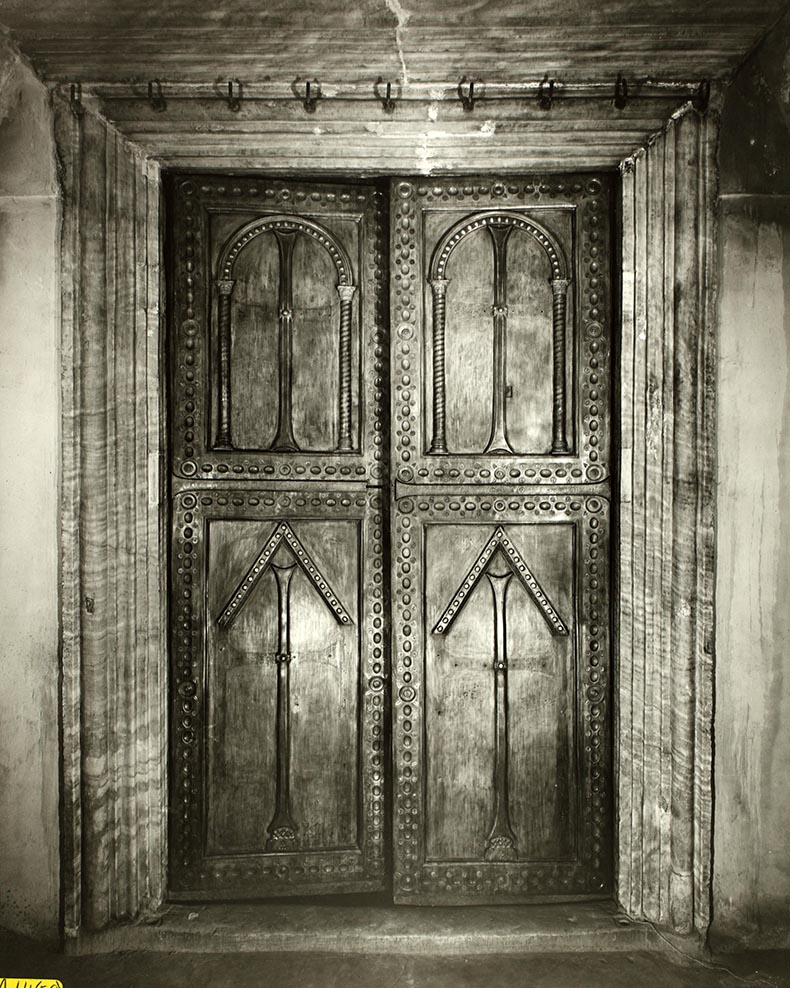 Above the door hooks for drapery have been sunk into the beautifully veined marble. There were drapes and tapestries all over the church Hagia Sophia. Entire sections of the church were curtained off for various reasons. You can still see the hooks for the drapery all over Hagia Sophia on the walls between the arches and from the ceiling. A byzantine scholar, Bruce Moran has mapped them all and has found thousands of Byzantine hooks still in their original positions. In some places there are still Byzantine curtain rods in place.
Above the door hooks for drapery have been sunk into the beautifully veined marble. There were drapes and tapestries all over the church Hagia Sophia. Entire sections of the church were curtained off for various reasons. You can still see the hooks for the drapery all over Hagia Sophia on the walls between the arches and from the ceiling. A byzantine scholar, Bruce Moran has mapped them all and has found thousands of Byzantine hooks still in their original positions. In some places there are still Byzantine curtain rods in place.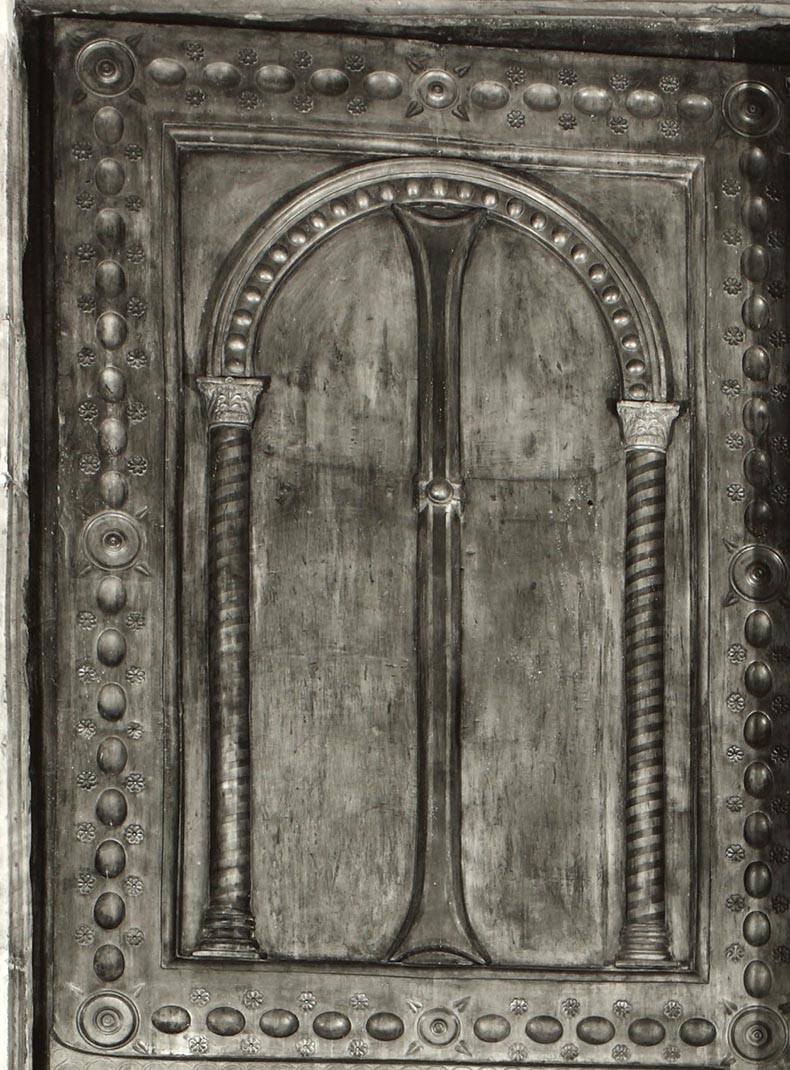 Here one can plainly see how the cross bars have been cut off. The little rosettes were attached after the casting of the doors - and were gilded. They have a higher percentage of copper, which made it easier to gild them.
Here one can plainly see how the cross bars have been cut off. The little rosettes were attached after the casting of the doors - and were gilded. They have a higher percentage of copper, which made it easier to gild them.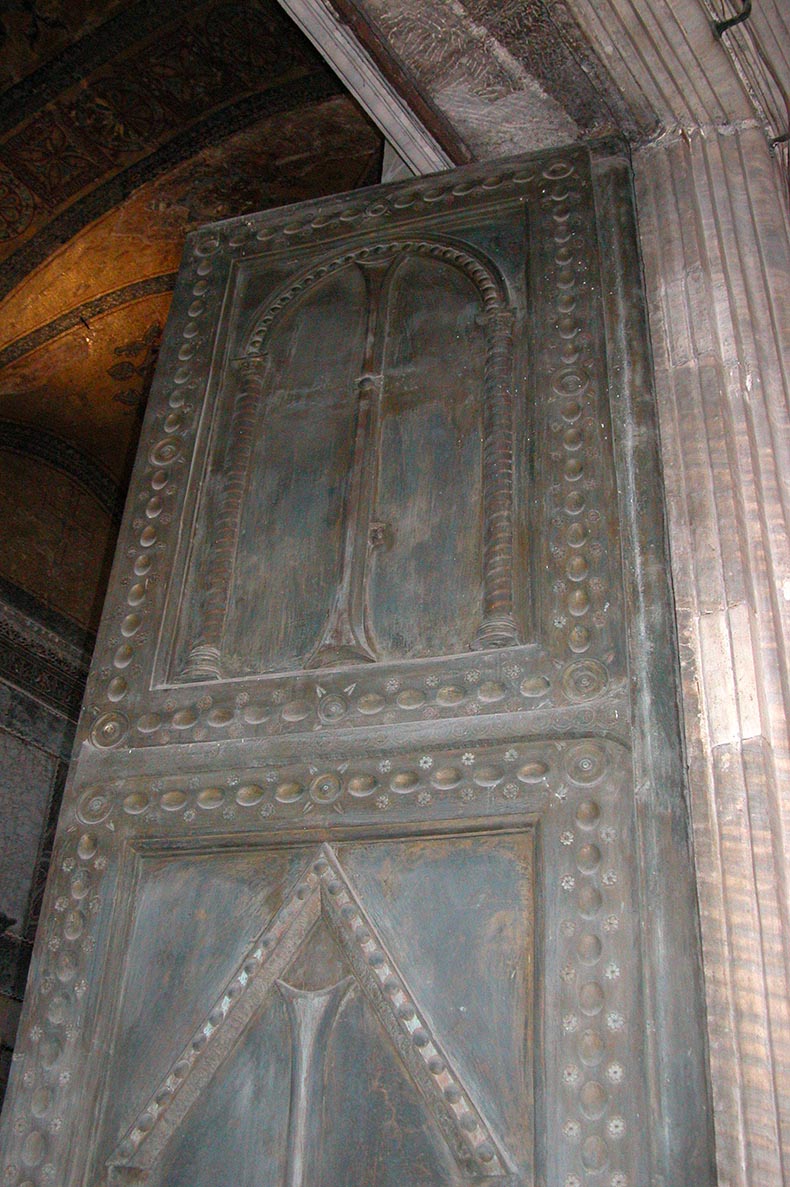 Those marks in the marble frame look like repairs where hinges once were.
Those marks in the marble frame look like repairs where hinges once were.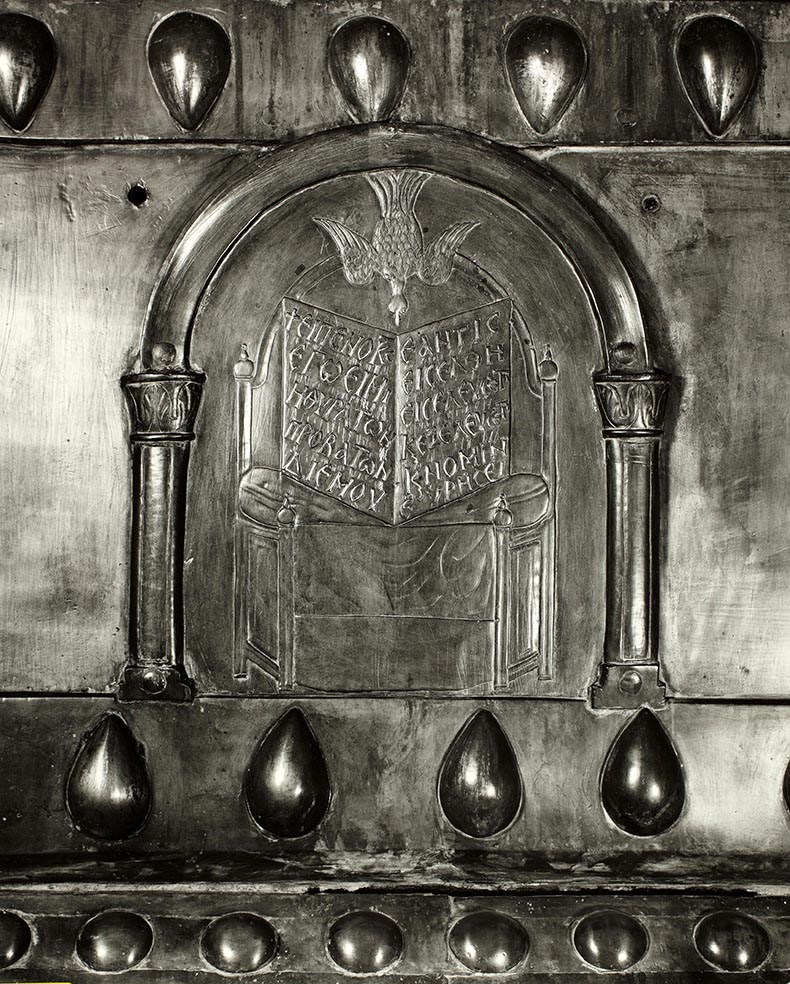 This is the inscription above the doors. The book bears a Greek inscription, an adapted quotation from the Gospel according to John 10:7-9: “So said the Lord: I am the door of the sheep. By me if any man enter, he shall go in and out, and find pasture”. The throne is an image of the Throne of the Second Coming (the Hetoimasia). A mosaic of the Hetoimasia was placed in the arch of the apse of Hagia Sophia. Part of the setting bed survives. The Church is the ark of the faithful and protects us from the storms and travails of life. The arch is a symbol of the ark. This seems a appropriate when the wood of the door was said to have come from Noah's Ark.
This is the inscription above the doors. The book bears a Greek inscription, an adapted quotation from the Gospel according to John 10:7-9: “So said the Lord: I am the door of the sheep. By me if any man enter, he shall go in and out, and find pasture”. The throne is an image of the Throne of the Second Coming (the Hetoimasia). A mosaic of the Hetoimasia was placed in the arch of the apse of Hagia Sophia. Part of the setting bed survives. The Church is the ark of the faithful and protects us from the storms and travails of life. The arch is a symbol of the ark. This seems a appropriate when the wood of the door was said to have come from Noah's Ark.
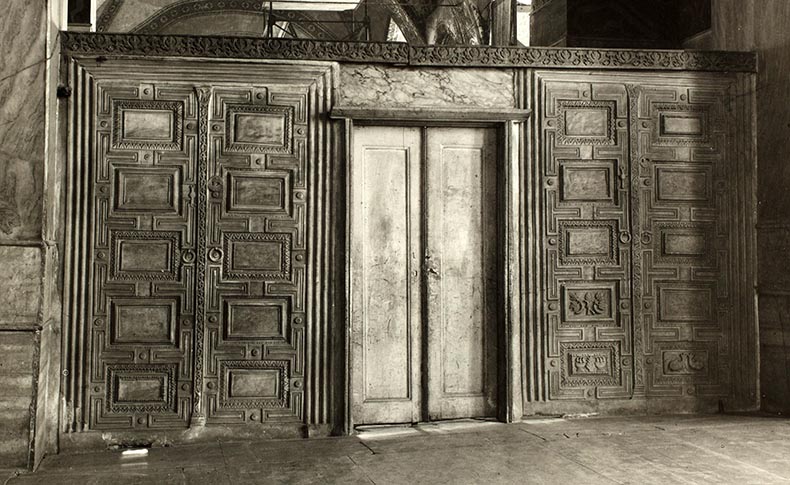 In the upper South Gallery there is a marble partition wall the separates the east end off from the rest of the floor. The use of the South Gallery evolved over the centuries. At first it was reserved for women of the court, the Empress and her attendants. Later it was used by the Clergy of Hagia Sophia who would meet the Imperial family here. The Emperor and his family would process along a long elevated passageway from the palace to the east end of Hagia Sophia., where a wooden ramp led to the door (this door now opens into space) between the mosaics of Constantine-Zoe and the Comnenians. This passageway was so impressive it as copied in Russia and Florence. It was big enough that you could ride a horse or be carried in a litter. There were windows in it that overlooked the city below. Zoe wanted the public to see her in the passage and who sit and look out at the city from there to see and be seen. When the Imperials entered Hagia Sophia here they could avoid the formal ceremonies that were required in a public visit on the ground floor. Here the Emperor and Empress could observe the Liturgy and services of Hagia Sophia without being seen. Church councils were held here. The Emperor could come and go as he wished from here back to the palace. I am sure that the marble partition was painted and gilded - just like ivories were. During the reign of the Emperor Romanos II the capitals of Hagia Sophia were all painted blue and then gilded, too.
In the upper South Gallery there is a marble partition wall the separates the east end off from the rest of the floor. The use of the South Gallery evolved over the centuries. At first it was reserved for women of the court, the Empress and her attendants. Later it was used by the Clergy of Hagia Sophia who would meet the Imperial family here. The Emperor and his family would process along a long elevated passageway from the palace to the east end of Hagia Sophia., where a wooden ramp led to the door (this door now opens into space) between the mosaics of Constantine-Zoe and the Comnenians. This passageway was so impressive it as copied in Russia and Florence. It was big enough that you could ride a horse or be carried in a litter. There were windows in it that overlooked the city below. Zoe wanted the public to see her in the passage and who sit and look out at the city from there to see and be seen. When the Imperials entered Hagia Sophia here they could avoid the formal ceremonies that were required in a public visit on the ground floor. Here the Emperor and Empress could observe the Liturgy and services of Hagia Sophia without being seen. Church councils were held here. The Emperor could come and go as he wished from here back to the palace. I am sure that the marble partition was painted and gilded - just like ivories were. During the reign of the Emperor Romanos II the capitals of Hagia Sophia were all painted blue and then gilded, too.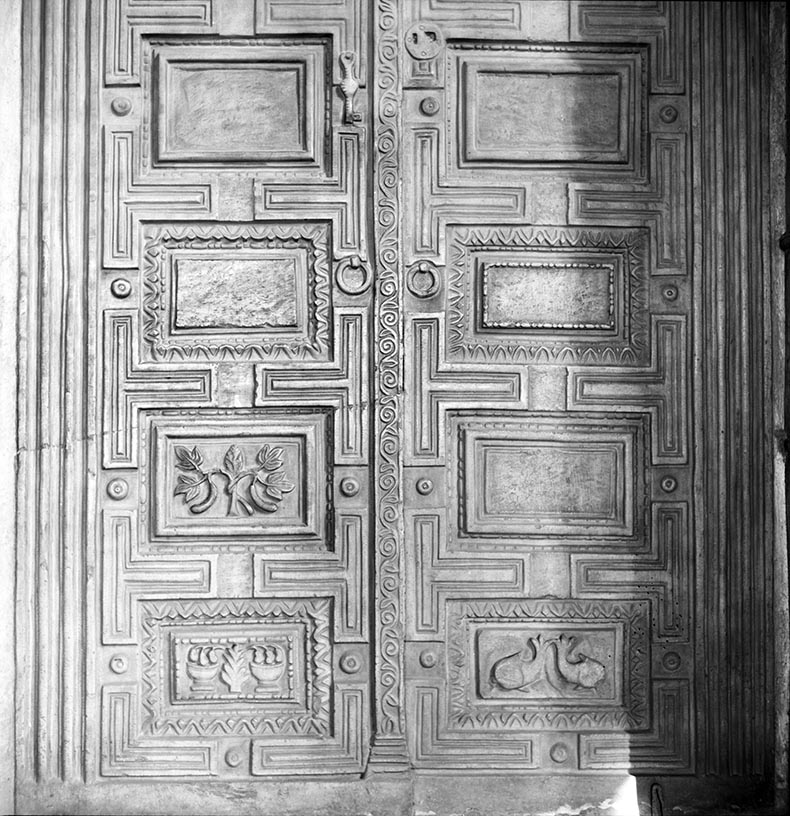
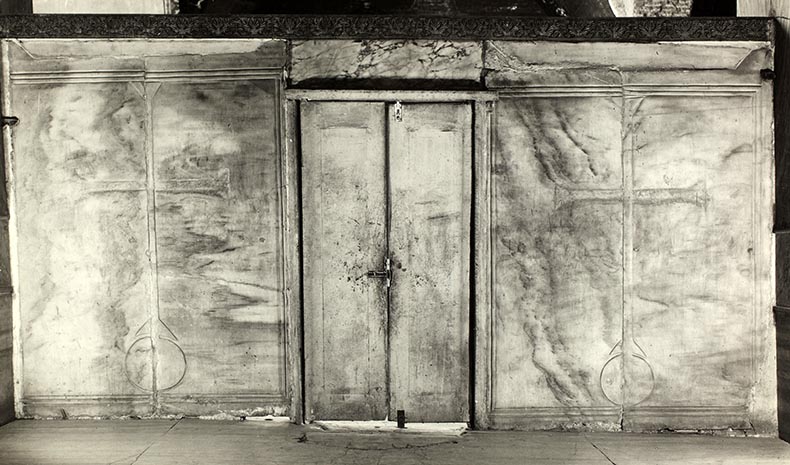 Thisis the back if the partition - you can see the arms of the crosses have been erased. A bad job. The front panels of the partition have also been intentionally damaged to remove images that were offensive to Muslims. The South Gallery was guarded by the Emperor's own Viking bodyguard - the Varangian. They have left at least one runic inscriptions scratched into a marble railing. There are scratched inscriptions all over Hagia Sophia, in a multitude of languages. The South Gallery was heavily draped off and embellished by silver candle stands, gilded and enamel icons on silver stands and many hanging silver candelabra with hanging and crystal lamps.
Thisis the back if the partition - you can see the arms of the crosses have been erased. A bad job. The front panels of the partition have also been intentionally damaged to remove images that were offensive to Muslims. The South Gallery was guarded by the Emperor's own Viking bodyguard - the Varangian. They have left at least one runic inscriptions scratched into a marble railing. There are scratched inscriptions all over Hagia Sophia, in a multitude of languages. The South Gallery was heavily draped off and embellished by silver candle stands, gilded and enamel icons on silver stands and many hanging silver candelabra with hanging and crystal lamps.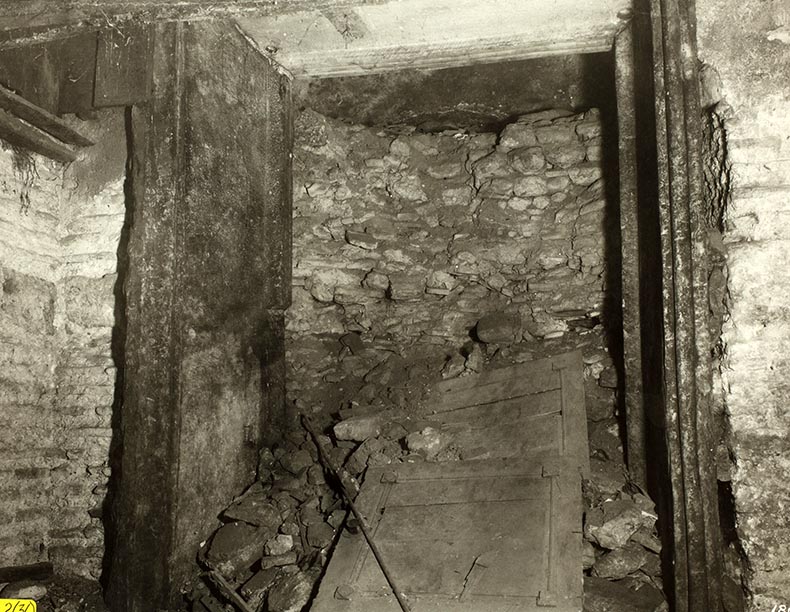 Is this a mystery door? it's the Horologia off the southwest vestibule - some badly preserved paintings where found nearby. Thousands of tourists walk by the shut door to the Horologia everyday - guess what's on the other side? Now you know. There are many mystery places like this all over Hagia Sophia. there's a second picture of the Horologia below. That big stone course is green stone which was used in the sixth century building of Hagia Sophia and it shows how old this room is.
Is this a mystery door? it's the Horologia off the southwest vestibule - some badly preserved paintings where found nearby. Thousands of tourists walk by the shut door to the Horologia everyday - guess what's on the other side? Now you know. There are many mystery places like this all over Hagia Sophia. there's a second picture of the Horologia below. That big stone course is green stone which was used in the sixth century building of Hagia Sophia and it shows how old this room is.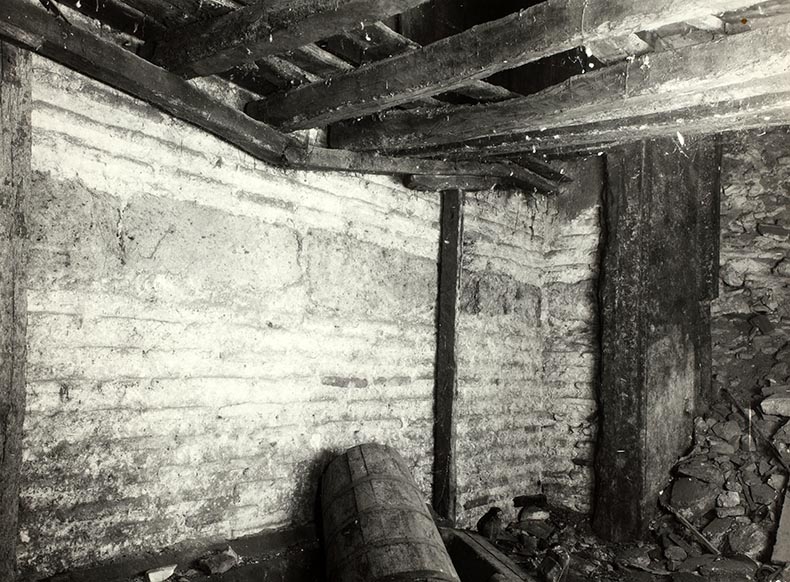
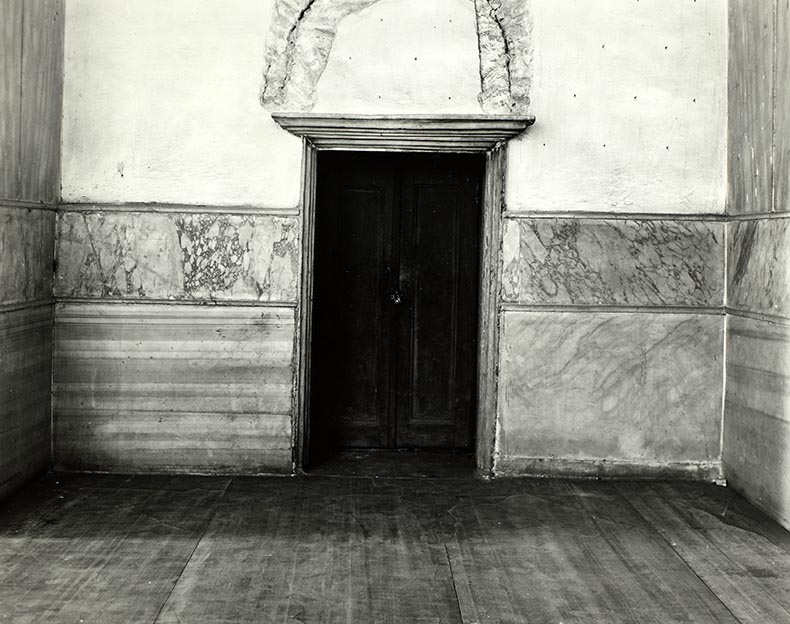 This is the door in the South Gallery that leads into one of the huge buttresses that were built to support the weight of the dome on the great arches that span the nave of Hagia Sophia. Every time I would visit Hagia Sophia I would try to open this door and get in because I had heard there were hidden passages and mysterious mosaics on the other side. Below is a picture from 1938 of an apsed room in the SW buttress with traces of mosaics. You can just make out the remains of three draped figures. The figure in the center is Christ holding a Gospels. One the left is a male saint. That's all I can make out by enlarging the image. From what little we can see the style of the drapery looks 9th century to me. I wonder if any of this remains. So, the stories turned out to be true but I was never able to open this door and get into the buttress and have not been able to discover whether they survived. I have just seen this drawing by Saltzenberg from 1850. I'll bet that drawing of standing Christ on the right is the same as this image below.
This is the door in the South Gallery that leads into one of the huge buttresses that were built to support the weight of the dome on the great arches that span the nave of Hagia Sophia. Every time I would visit Hagia Sophia I would try to open this door and get in because I had heard there were hidden passages and mysterious mosaics on the other side. Below is a picture from 1938 of an apsed room in the SW buttress with traces of mosaics. You can just make out the remains of three draped figures. The figure in the center is Christ holding a Gospels. One the left is a male saint. That's all I can make out by enlarging the image. From what little we can see the style of the drapery looks 9th century to me. I wonder if any of this remains. So, the stories turned out to be true but I was never able to open this door and get into the buttress and have not been able to discover whether they survived. I have just seen this drawing by Saltzenberg from 1850. I'll bet that drawing of standing Christ on the right is the same as this image below.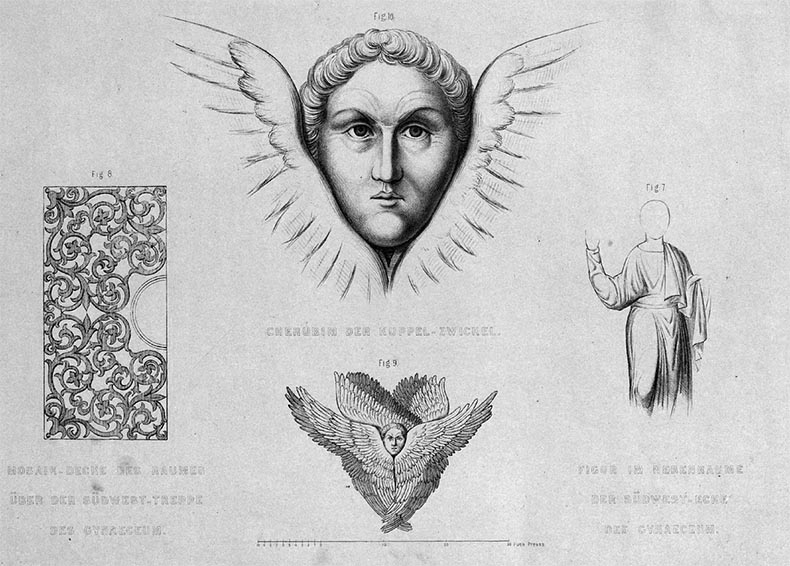
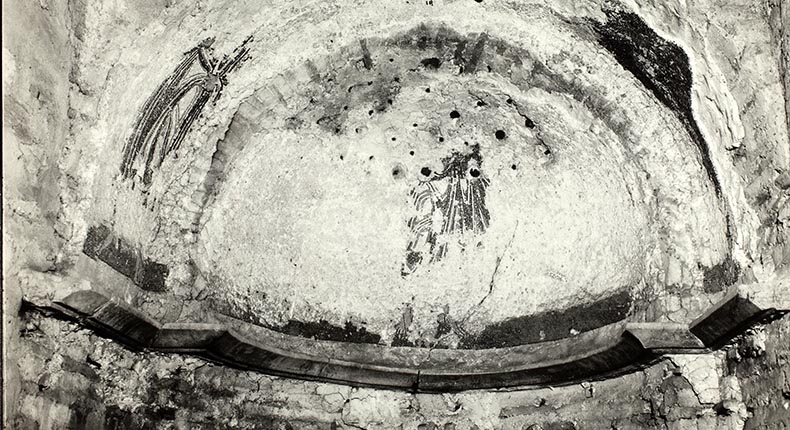 This side of Hagia Sophia was the location of the Patriarchate, its offices and reception rooms. These chambers and rooms climbed up the side of the church and attached to the South Gallery. In recent years rooms and halls of the patriarchate have been identified. What was assumed to have been the Baptistery of Hagia Sophia turned out to have been a reception hall for the Patriarch. Experts thought it was a baptistery because a huge marble basin had been found nearby. It seems it had been moved here after 1453.
This side of Hagia Sophia was the location of the Patriarchate, its offices and reception rooms. These chambers and rooms climbed up the side of the church and attached to the South Gallery. In recent years rooms and halls of the patriarchate have been identified. What was assumed to have been the Baptistery of Hagia Sophia turned out to have been a reception hall for the Patriarch. Experts thought it was a baptistery because a huge marble basin had been found nearby. It seems it had been moved here after 1453.
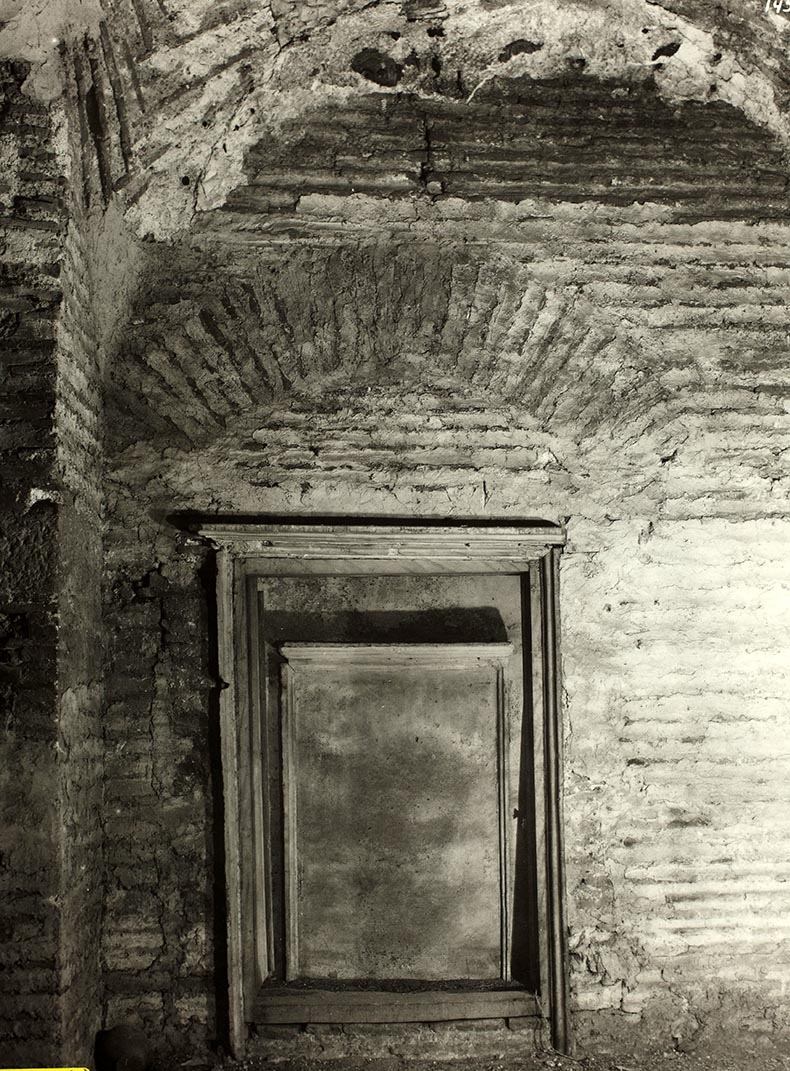 This is the mysterious "Room 2, looking west toward room 1, west wall" - I have no idea where room 2 is. Did you know there is a secret chapel of Saint Nicholas near the apse of Hagia Sophia with marble shelves?
This is the mysterious "Room 2, looking west toward room 1, west wall" - I have no idea where room 2 is. Did you know there is a secret chapel of Saint Nicholas near the apse of Hagia Sophia with marble shelves?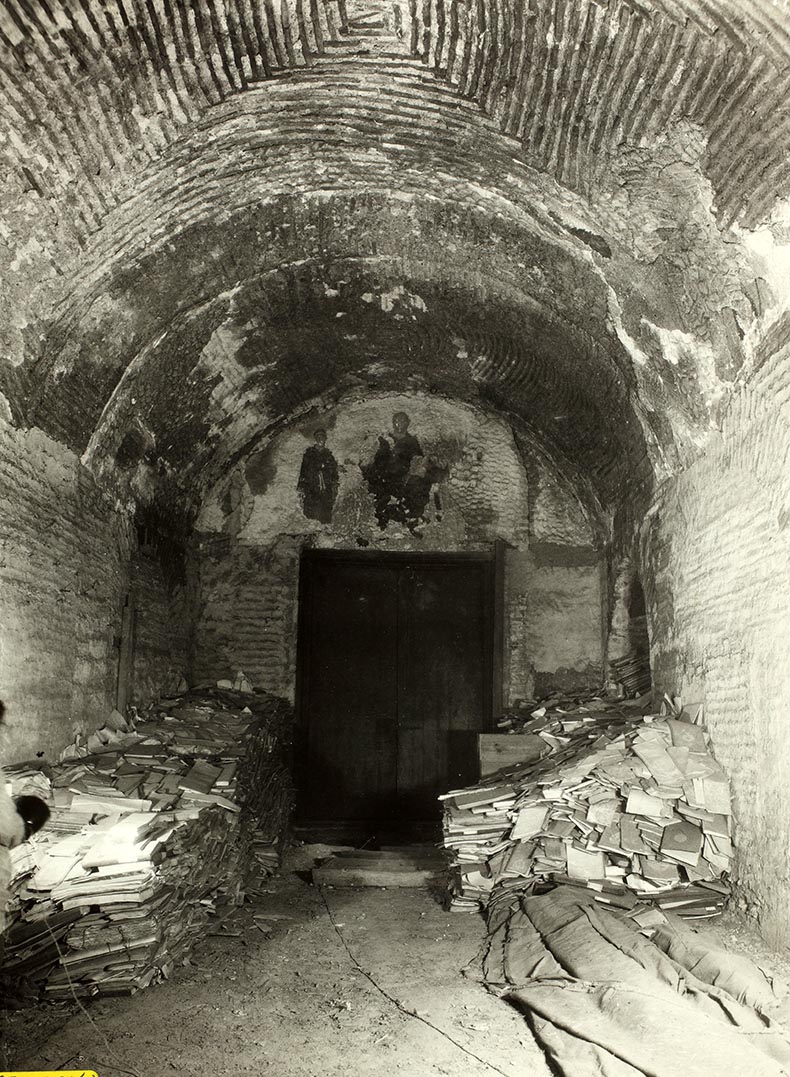 This final picture shows the famous - in fact infamous - room that no one can get into - The Room Over The Vestibule, where Robin Cormack was - perhaps - the last foreign scholar to get in. There was a preliminary season of investigation (1950) in the rooms, and then a second after conservation, cleaning, and photography was completed in 1954, by Paul Underwood and his team. What a mess! Istanbul used to be full of hidden Byzantine spaces like this - they have all been cleared away to make room for restaurants and new mosques.
This final picture shows the famous - in fact infamous - room that no one can get into - The Room Over The Vestibule, where Robin Cormack was - perhaps - the last foreign scholar to get in. There was a preliminary season of investigation (1950) in the rooms, and then a second after conservation, cleaning, and photography was completed in 1954, by Paul Underwood and his team. What a mess! Istanbul used to be full of hidden Byzantine spaces like this - they have all been cleared away to make room for restaurants and new mosques.
Bob Atchison
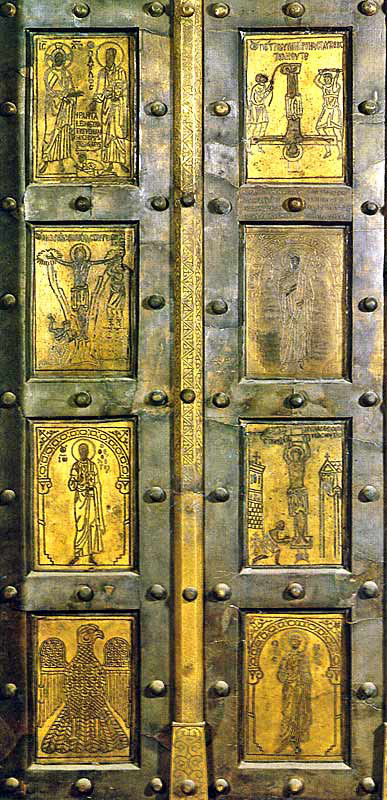
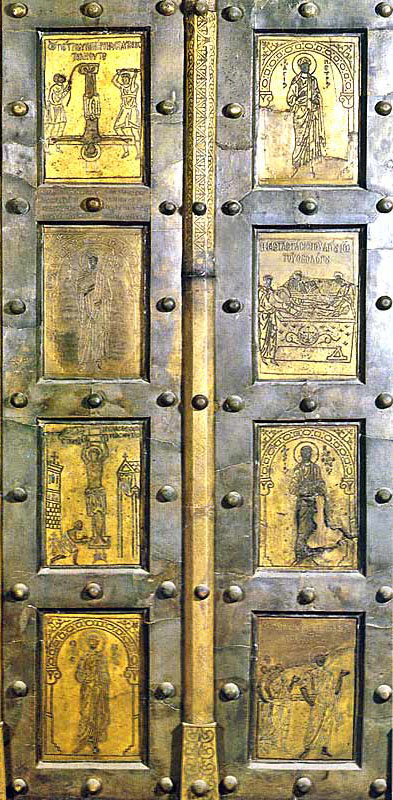
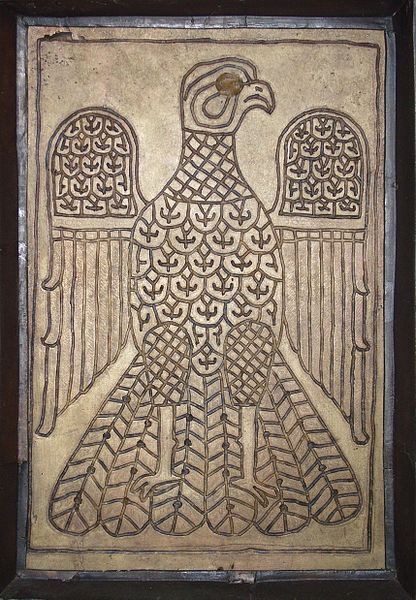
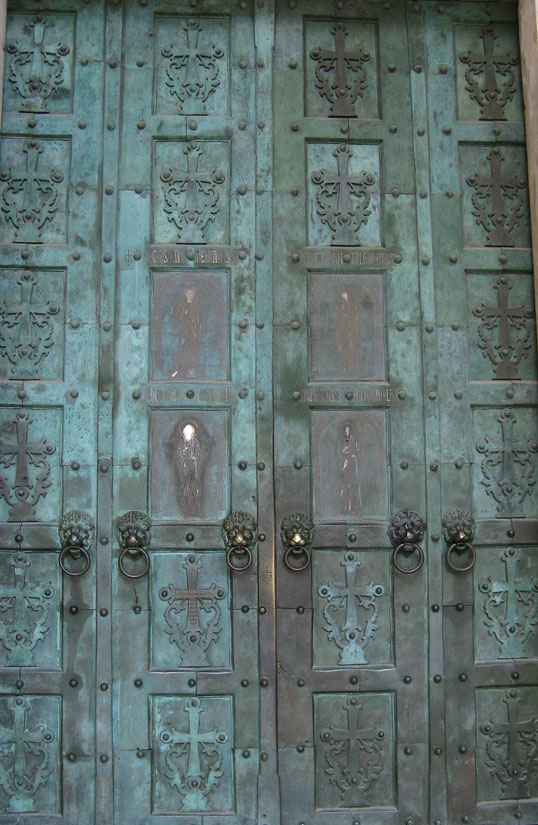 The door below is 12th century and came from Constantinople. It adorned a cathedral in Vladimir-Suzdal and arrived at the same time as the famous icon called Our Lady of Vladimir. John II Komnenos married two of his sons to Russian princesses. Both of them became scholars, one was a famous expert on in medicine whose writings survive until today. They spoke amazingly beautiful Greek as if it was their native language.
The door below is 12th century and came from Constantinople. It adorned a cathedral in Vladimir-Suzdal and arrived at the same time as the famous icon called Our Lady of Vladimir. John II Komnenos married two of his sons to Russian princesses. Both of them became scholars, one was a famous expert on in medicine whose writings survive until today. They spoke amazingly beautiful Greek as if it was their native language.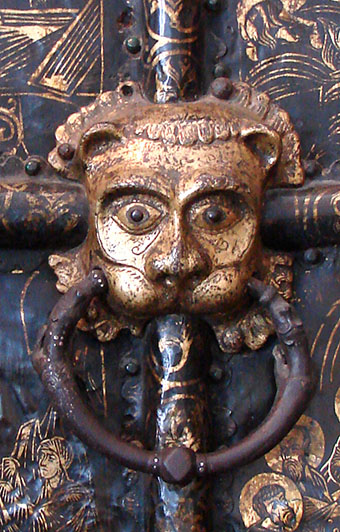
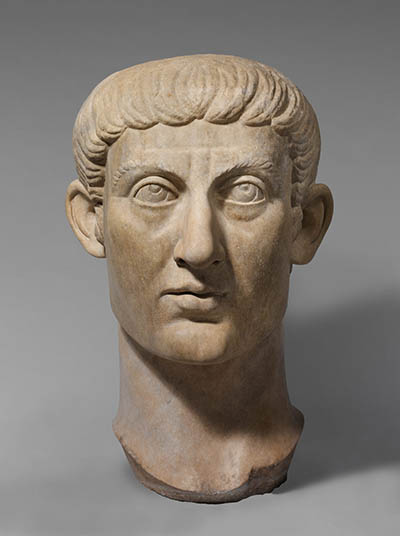 This marble head of Constantine is big - 37 inches tall and weighs more than 1100 lbs. We don't know hat kind of marble it is carved in, but it looks mass-produced in middle-grade stone. It was probably from a mass order for heads to be inserted into over-life-sized statues. It would have been easier to ship the heads from a central workshop around the empire. There would have been many statues that could be found that could have the heads switched out. This was done all the time. Since the head was meant to be placed in another statue - most likely with drapery over the head, it was not necessary to finish the hair.
This marble head of Constantine is big - 37 inches tall and weighs more than 1100 lbs. We don't know hat kind of marble it is carved in, but it looks mass-produced in middle-grade stone. It was probably from a mass order for heads to be inserted into over-life-sized statues. It would have been easier to ship the heads from a central workshop around the empire. There would have been many statues that could be found that could have the heads switched out. This was done all the time. Since the head was meant to be placed in another statue - most likely with drapery over the head, it was not necessary to finish the hair.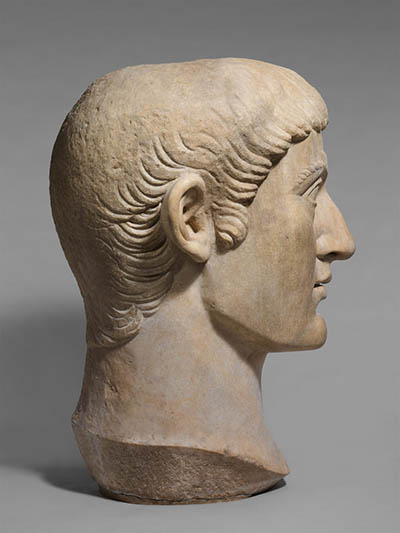 Wow, what a profile! The portrait head resembles Augustus. The mouth and chin are finely modeled. The resemblance to Augustus would have been intentional.
Wow, what a profile! The portrait head resembles Augustus. The mouth and chin are finely modeled. The resemblance to Augustus would have been intentional.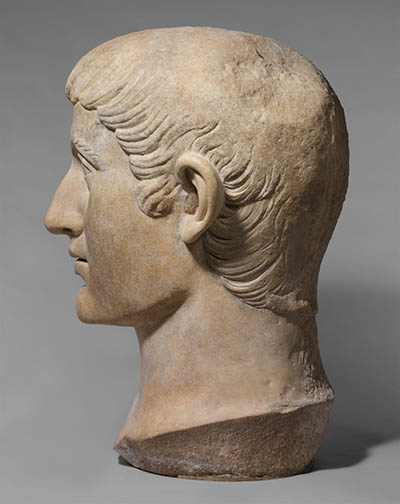 This bust has survived in an amazing condition. The nose is perfect.
This bust has survived in an amazing condition. The nose is perfect.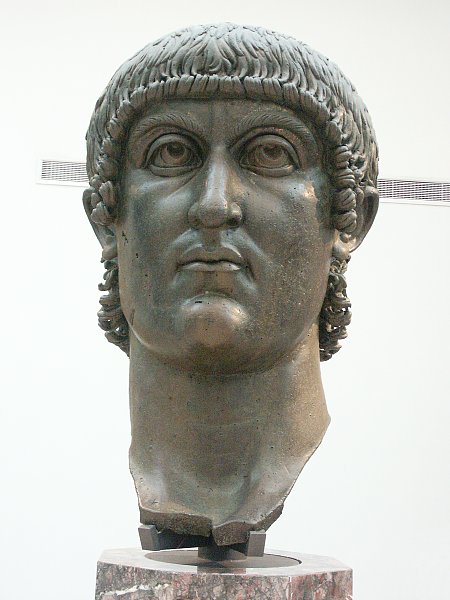 This colossal bronze statue of Constantine is in the Capitoline Museum in Rome. A finger from this statue has recently been connected to the hand. The hand is below. The finger has been previously believed to be a toe from another, unknown, colossal bronze.
This colossal bronze statue of Constantine is in the Capitoline Museum in Rome. A finger from this statue has recently been connected to the hand. The hand is below. The finger has been previously believed to be a toe from another, unknown, colossal bronze.
.jpg)

 The center door was called the Royal Door and only the Emperor could pass through it on special days. At the ritual entrance of the Emperor to Hagia Sophia, holding a large candle, he would bow three times before this door, while choirs chanted. It's huge and massive planks were said to be wood from Noah's Ark, a story first recorded in the 9th century. The Partia Constantinopoleos informs us: “In the second narthex the doors were made of ivory (three to the right, three to the left, and between them) three other doors: two of the middle size, and between them there was the very big one of gilded silver. All the doors were gilded. Inside these doors instead of normal wood there was the Wood of the Ark”
The center door was called the Royal Door and only the Emperor could pass through it on special days. At the ritual entrance of the Emperor to Hagia Sophia, holding a large candle, he would bow three times before this door, while choirs chanted. It's huge and massive planks were said to be wood from Noah's Ark, a story first recorded in the 9th century. The Partia Constantinopoleos informs us: “In the second narthex the doors were made of ivory (three to the right, three to the left, and between them) three other doors: two of the middle size, and between them there was the very big one of gilded silver. All the doors were gilded. Inside these doors instead of normal wood there was the Wood of the Ark” The door has a brass frame that dates from either the 6th century or the ninth century. Based on the style of the text, most recent scholarship supports a later date. Along the top are a series of hooks in the shape of fingers The brass has the same fine ornamentation in its borders as the other doors in Hagia Sophia. I don't know if the brass frame was ever gilded. I think not, since the only gilding method that could be oil based one. Brass can be kept polished to a very fine gold-like finish, let's assume that's what was done.
The door has a brass frame that dates from either the 6th century or the ninth century. Based on the style of the text, most recent scholarship supports a later date. Along the top are a series of hooks in the shape of fingers The brass has the same fine ornamentation in its borders as the other doors in Hagia Sophia. I don't know if the brass frame was ever gilded. I think not, since the only gilding method that could be oil based one. Brass can be kept polished to a very fine gold-like finish, let's assume that's what was done. Here's a view through the doors showing what it looks like today. In Byzantine times there were only a couple of days a year when it was opened. When Hagia Sophia was a mosque this door was reserved for the Sultan and was covered with silk draperies with Koranic inscriptions. The fllor in front of the door still shows the impressions left by hundreds of thousands of Christian Pilgrims who knelt in from of the icons on either side of the door.
Here's a view through the doors showing what it looks like today. In Byzantine times there were only a couple of days a year when it was opened. When Hagia Sophia was a mosque this door was reserved for the Sultan and was covered with silk draperies with Koranic inscriptions. The fllor in front of the door still shows the impressions left by hundreds of thousands of Christian Pilgrims who knelt in from of the icons on either side of the door. All of the doors have mythical stories of the origin of their wood. These were covered in bronze. The motifs are 6th century Byzantine interpretations of classical motifs like acanthus. The Byzantines were famous for their bronze doors that were inlaid with gold and silver, which were sent all over the
All of the doors have mythical stories of the origin of their wood. These were covered in bronze. The motifs are 6th century Byzantine interpretations of classical motifs like acanthus. The Byzantines were famous for their bronze doors that were inlaid with gold and silver, which were sent all over the  The bars of the crosses on all of the doors have been removed after Hagia Sophia was converted into a mosque. The rest of the ornament on the bottom panels has also disappeared.
The bars of the crosses on all of the doors have been removed after Hagia Sophia was converted into a mosque. The rest of the ornament on the bottom panels has also disappeared. Here you can see areas of incised ornament that was gilded. These mimic metal straps that would have been used to secure wood panels.
Here you can see areas of incised ornament that was gilded. These mimic metal straps that would have been used to secure wood panels. Above the door hooks for drapery have been sunk into the beautifully veined marble. There were drapes and tapestries all over the church Hagia Sophia. Entire sections of the church were curtained off for various reasons. You can still see the hooks for the drapery all over Hagia Sophia on the walls between the arches and from the ceiling. A byzantine scholar, Bruce Moran has mapped them all and has found thousands of Byzantine hooks still in their original positions. In some places there are still Byzantine curtain rods in place.
Above the door hooks for drapery have been sunk into the beautifully veined marble. There were drapes and tapestries all over the church Hagia Sophia. Entire sections of the church were curtained off for various reasons. You can still see the hooks for the drapery all over Hagia Sophia on the walls between the arches and from the ceiling. A byzantine scholar, Bruce Moran has mapped them all and has found thousands of Byzantine hooks still in their original positions. In some places there are still Byzantine curtain rods in place. Here one can plainly see how the cross bars have been cut off. The little rosettes were attached after the casting of the doors - and were gilded. They have a higher percentage of copper, which made it easier to gild them.
Here one can plainly see how the cross bars have been cut off. The little rosettes were attached after the casting of the doors - and were gilded. They have a higher percentage of copper, which made it easier to gild them. Those marks in the marble frame look like repairs where hinges once were.
Those marks in the marble frame look like repairs where hinges once were. This is the inscription above the doors. The book bears a Greek inscription, an adapted quotation from the Gospel according to John 10:7-9: “So said the Lord: I am the door of the sheep. By me if any man enter, he shall go in and out, and find pasture”. The throne is an image of the Throne of the Second Coming (the Hetoimasia). A mosaic of the Hetoimasia was placed in the arch of the apse of Hagia Sophia. Part of the setting bed survives. The Church is the ark of the faithful and protects us from the storms and travails of life. The arch is a symbol of the ark. This seems a appropriate when the wood of the door was said to have come from Noah's Ark.
This is the inscription above the doors. The book bears a Greek inscription, an adapted quotation from the Gospel according to John 10:7-9: “So said the Lord: I am the door of the sheep. By me if any man enter, he shall go in and out, and find pasture”. The throne is an image of the Throne of the Second Coming (the Hetoimasia). A mosaic of the Hetoimasia was placed in the arch of the apse of Hagia Sophia. Part of the setting bed survives. The Church is the ark of the faithful and protects us from the storms and travails of life. The arch is a symbol of the ark. This seems a appropriate when the wood of the door was said to have come from Noah's Ark. In the upper South Gallery there is a marble partition wall the separates the east end off from the rest of the floor. The use of the South Gallery evolved over the centuries. At first it was reserved for women of the court, the Empress and her attendants. Later it was used by the Clergy of Hagia Sophia who would meet the Imperial family here. The Emperor and his family would process along a long elevated passageway from the palace to the east end of Hagia Sophia., where a wooden ramp led to the door (this door now opens into space) between the mosaics of Constantine-Zoe and the Comnenians. This passageway was so impressive it as copied in Russia and Florence. It was big enough that you could ride a horse or be carried in a litter. There were windows in it that overlooked the city below. Zoe wanted the public to see her in the passage and who sit and look out at the city from there to see and be seen. When the Imperials entered Hagia Sophia here they could avoid the formal ceremonies that were required in a public visit on the ground floor. Here the Emperor and Empress could observe the Liturgy and services of Hagia Sophia without being seen. Church councils were held here. The Emperor could come and go as he wished from here back to the palace. I am sure that the marble partition was painted and gilded - just like ivories were. During the reign of the Emperor Romanos II the capitals of Hagia Sophia were all painted blue and then gilded, too.
In the upper South Gallery there is a marble partition wall the separates the east end off from the rest of the floor. The use of the South Gallery evolved over the centuries. At first it was reserved for women of the court, the Empress and her attendants. Later it was used by the Clergy of Hagia Sophia who would meet the Imperial family here. The Emperor and his family would process along a long elevated passageway from the palace to the east end of Hagia Sophia., where a wooden ramp led to the door (this door now opens into space) between the mosaics of Constantine-Zoe and the Comnenians. This passageway was so impressive it as copied in Russia and Florence. It was big enough that you could ride a horse or be carried in a litter. There were windows in it that overlooked the city below. Zoe wanted the public to see her in the passage and who sit and look out at the city from there to see and be seen. When the Imperials entered Hagia Sophia here they could avoid the formal ceremonies that were required in a public visit on the ground floor. Here the Emperor and Empress could observe the Liturgy and services of Hagia Sophia without being seen. Church councils were held here. The Emperor could come and go as he wished from here back to the palace. I am sure that the marble partition was painted and gilded - just like ivories were. During the reign of the Emperor Romanos II the capitals of Hagia Sophia were all painted blue and then gilded, too.
 Thisis the back if the partition - you can see the arms of the crosses have been erased. A bad job. The front panels of the partition have also been intentionally damaged to remove images that were offensive to Muslims. The South Gallery was guarded by the Emperor's own Viking bodyguard - the Varangian. They have left at least one runic inscriptions scratched into a marble railing. There are scratched inscriptions all over Hagia Sophia, in a multitude of languages. The South Gallery was heavily draped off and embellished by silver candle stands, gilded and enamel icons on silver stands and many hanging silver candelabra with hanging and crystal lamps.
Thisis the back if the partition - you can see the arms of the crosses have been erased. A bad job. The front panels of the partition have also been intentionally damaged to remove images that were offensive to Muslims. The South Gallery was guarded by the Emperor's own Viking bodyguard - the Varangian. They have left at least one runic inscriptions scratched into a marble railing. There are scratched inscriptions all over Hagia Sophia, in a multitude of languages. The South Gallery was heavily draped off and embellished by silver candle stands, gilded and enamel icons on silver stands and many hanging silver candelabra with hanging and crystal lamps. Is this a mystery door? it's the Horologia off the southwest vestibule - some badly preserved paintings where found nearby. Thousands of tourists walk by the shut door to the Horologia everyday - guess what's on the other side? Now you know. There are many mystery places like this all over Hagia Sophia. there's a second picture of the Horologia below. That big stone course is green stone which was used in the sixth century building of Hagia Sophia and it shows how old this room is.
Is this a mystery door? it's the Horologia off the southwest vestibule - some badly preserved paintings where found nearby. Thousands of tourists walk by the shut door to the Horologia everyday - guess what's on the other side? Now you know. There are many mystery places like this all over Hagia Sophia. there's a second picture of the Horologia below. That big stone course is green stone which was used in the sixth century building of Hagia Sophia and it shows how old this room is.
 This is the door in the South Gallery that leads into one of the huge buttresses that were built to support the weight of the dome on the great arches that span the nave of Hagia Sophia. Every time I would visit Hagia Sophia I would try to open this door and get in because I had heard there were hidden passages and mysterious mosaics on the other side. Below is a picture from 1938 of an apsed room in the SW buttress with traces of mosaics. You can just make out the remains of three draped figures. The figure in the center is Christ holding a Gospels. One the left is a male saint. That's all I can make out by enlarging the image. From what little we can see the style of the drapery looks 9th century to me. I wonder if any of this remains. So, the stories turned out to be true but I was never able to open this door and get into the buttress and have not been able to discover whether they survived. I have just seen this drawing by Saltzenberg from 1850. I'll bet that drawing of standing Christ on the right is the same as this image below.
This is the door in the South Gallery that leads into one of the huge buttresses that were built to support the weight of the dome on the great arches that span the nave of Hagia Sophia. Every time I would visit Hagia Sophia I would try to open this door and get in because I had heard there were hidden passages and mysterious mosaics on the other side. Below is a picture from 1938 of an apsed room in the SW buttress with traces of mosaics. You can just make out the remains of three draped figures. The figure in the center is Christ holding a Gospels. One the left is a male saint. That's all I can make out by enlarging the image. From what little we can see the style of the drapery looks 9th century to me. I wonder if any of this remains. So, the stories turned out to be true but I was never able to open this door and get into the buttress and have not been able to discover whether they survived. I have just seen this drawing by Saltzenberg from 1850. I'll bet that drawing of standing Christ on the right is the same as this image below.
 This side of Hagia Sophia was the location of the P
This side of Hagia Sophia was the location of the P This is the mysterious "Room 2, looking west toward room 1, west wall" - I have no idea where room 2 is. Did you know there is a secret chapel of Saint Nicholas near the apse of Hagia Sophia with marble shelves?
This is the mysterious "Room 2, looking west toward room 1, west wall" - I have no idea where room 2 is. Did you know there is a secret chapel of Saint Nicholas near the apse of Hagia Sophia with marble shelves? This final picture shows the famous - in fact infamous - room that no one can get into - The Room Over The Vestibule, where Robin Cormack was - perhaps - the last foreign scholar to get in. There was a preliminary season of investigation (1950) in the rooms, and then a second after conservation, cleaning, and photography was completed in 1954, by Paul Underwood and his team. What a mess! Istanbul used to be full of hidden Byzantine spaces like this - they have all been cleared away to make room for restaurants and new mosques.
This final picture shows the famous - in fact infamous - room that no one can get into - The Room Over The Vestibule, where Robin Cormack was - perhaps - the last foreign scholar to get in. There was a preliminary season of investigation (1950) in the rooms, and then a second after conservation, cleaning, and photography was completed in 1954, by Paul Underwood and his team. What a mess! Istanbul used to be full of hidden Byzantine spaces like this - they have all been cleared away to make room for restaurants and new mosques.



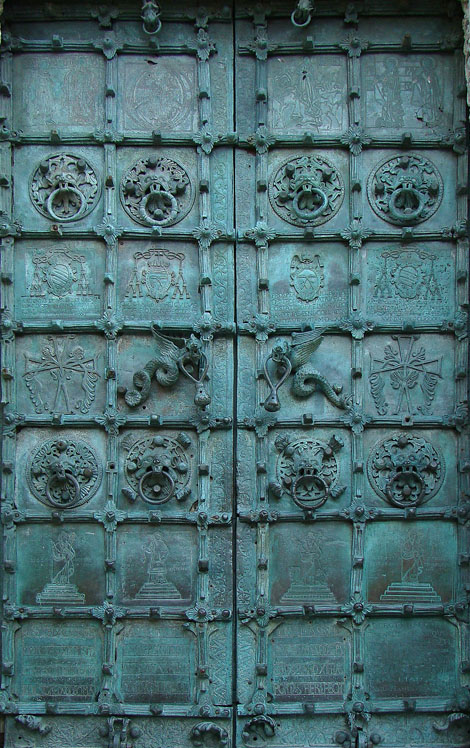
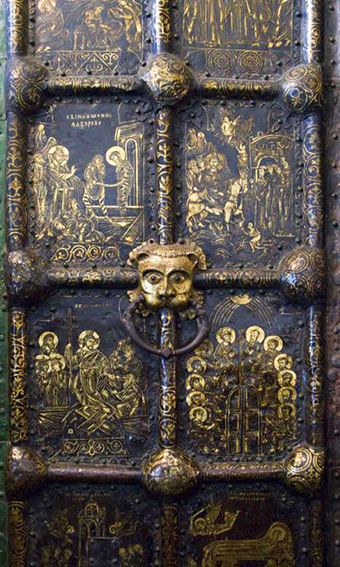
 click here for icons of christ
click here for icons of christ click here for icons of the theotokos
click here for icons of the theotokos click here for icons of angels
click here for icons of angels click here for icons of saints
click here for icons of saints








